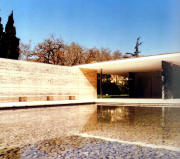




 |
|
‘Who can
say what beauty is.’ - I don’t want to address this question as an architect
or city planner - I have already done this in Cottbus some time ago - but I
want to address it as chairwoman of the Union of German Architects (better
known by the acronym BDA of its German name Bund deutscher Architekten) of
the Federal Land Berlin. The BDA has recently turned 100 years old and has
barely managed to escape insolvency. Because of the poorly attended congress
of world architects in Berlin it has to pay off a huge debt mountain.
But this shall not be today’s topic.
My talk is divided into three parts: firstly I will try to fathom out the
‘character’ of the BDA and to describe it for all those who are not familiar
with this organization.
Secondly, with the help of a digression into the world of operas, I will
show some major problems of aesthetic selection procedures.
Finally, the BDA will be looked at in comparison with other institutions
with similar objectives.
Originally, today’s talk was planned to bear the title: ‘Of Unions,
Beckmessers and Building Culture’. But, after all, I have chosen a rather
academic title. Independently of my talk today, some weeks ago in the far
away Land of Baden-Württemberg, on the occasion of a presentation of prizes
by the BDA, the Stuttgart architect Arno Lederer delivered a talk with the
title ‘Do We Need Unions?’.
In this talk, Lederer analyzes the meaning of the notion ‘union’ in a wide
arc from the BDM - Bund deutscher Mädchen (Union of German Girls) to the Old
Testament union between God and Moses’
descendants.
His
conclusion is that ‘the bundling takes place because of the idea, the
union is an intellectual construct. If the members serve the idea, the union
will be successful. Otherwise it will fail – because only the idea keeps the
union alive.’
But
what exactly is the idea of the BDA? The statutes say succinctly:
‘The
objective of the BDA is the quality of planning and building in
responsibility for society and surroundings.’
To the BDA will be appointed:
‘Architects
and urban planners who carry out their tasks independently… Prerequisites
are personal integrity, above-average
professional qualifications – proven by own works; personal attitude towards
the profession which corresponds to the goals of the BDA.’
The members of the BDA are selected by an appeal tribunal - except for the
above mentioned, there are no other criteria of selection. One could sum up:
the members of the BDA decide about
who gets to join the union - and the union is by no means open to everyone.
Even in times of scarce financial means, in Berlin for
example, more applicants have been turned down than considered as worthy for
being admitted. Actually, no-one should be applying for membership anyway -
the members get appointed.
I do not want to muse about
whether such things like universally valid esthetic criteria actually exist
or not. Instead I have prepared a small test which might provide the answer
to this question. In the following I will show six examples of buildings.
Two of the planners have been rejected the membership of the BDA, the other
four are or were members of the BDA. I will now distribute small cards on
which each conference participant should note the architects, i.e. architect
A, B, C, D, E, F whom, according to these photos, he would appoint to the
BDA.
Later on during my talk we will have counted the result. Out of these six
introduced architects, everyone can name as many as he or she would allow to
join the BDA.
|
| |
|
Of course this principle also reminds us of another institution which we
know from the Middle Ages: the guild. A guild consists of masters. As soon
as one has handed in his masterpiece and this has been accepted as such, the
ones who have already been accepted to the guild, regulate the membership of
newcomers. Let’s have a digression into an opera which wrongly has a
negative connotation - it was the favorite opera of the so-called Leader.
(We might be able to see later why it was his favorite opera). I am speaking
about Richard Wagner’s opera ‘The Meistersinger of Nürnberg’, first
performance in 1870, i.e. 33 years before the foundation of the BDA.
Wagner himself has written plots and texts of his operas - some are
considered as bad - whereas his music should be beyond all doubt.
But nevertheless it is the plot of this opera which is of special interest
for us. One of the characters, the Beckmesser, has become part of a German
proverb – so let’s see how this has happened.
|
 |
|
Scene of the action is Nuremberg, the German town per se
during the Middle Ages. It is not architecture that is to be discussed here
but Meistergesang. There is a guild of Meistersingers, with Hans Sachs as
the head. Beckmesser is the name of a respected although awkward council
member who is a so-called ‘Merker’, i.e. he is in charge of the compliance
with the rules. I don’t want to elaborate
on details of the plot. At a singing contest, the hand of a beautiful
daughter and sole heiress of one of the guild’s members is offered as first
price. I will start with the scene in which this fact is discussed within
the guild.
Pogner.
A Meistersinger he has to be - only whom you crown shall marry she.
Sachs: Now if you will present to the people how high you honour art,
and if you leave the choice to the child, not wanting her to disagree with
the vote, then let the people be judge, its choice will surely harmonize
with hers.
All Meisters: The people ? Now that´s nice ! Good-bye then art and
masterly tunes !
Sachs: Admit I know the rules well, and that the Union
[Zunft] obey the rules has been my concern for many a year. But once a year
it would be wise I think to review the rules, to see if not by habit
they´ve lost their vigour and life (and if one still follows nature´s trail,
can only tell who knows nothing of tabulature).
Walter von Stolzing, a young nobleman, has fallen in love with the daughter.
But in order to get her he has to participate in the singing contest
although he does not belong to the guild of the Meistersinger. In order to
have a complete command of the rules he takes a crash course with Hans Sachs
and composes a new type of song. Because of some confusions, his composition
ends up in the hands of Beckmesser who has had designs on the bride for a
long time.
|
 |
|
Beckmesser himself sings this song on the occasion of the contest that takes
place on Midsummer’s Day. But because of his sound musical training he
doesn’t understand the new kind of tonality (which of course symbolizes
Wagner’s new way of composing) and he makes a fool of himself in front of
the people who have come to attend the contest. He virtually performs a
Dadaist show. Now Hans Sachs reveals the real author and Walter von Stolzing
sings his song. And here comes the surprise: People and Meistersinger -
except Beckmesser - are enthusiastic. The singers draw the conclusion:
‘It is indeed bold and peculiar, but well rhymed and singable!
Very peculiar! Very bold!’
They now offer Walter von Stolzing the membership in their guild, which also
means that he would be given Eva as his bride, but let’s see his answer:
Walther: Not Meister, no! (Casts a tender glance on Eva) I
want to be happy without being one.
Sachs: Don´t you disregard the Meisters ! For you were richly blessed
with the gift that they are known and famous for. Not to your ancestors -
deer as they may be - nor to your banner, spear or sword is it that you owe
your highest bliss today. It is because you are a poet, chosen by a Meister.
So why this digression into a two hundred years old and rather disreputable
opera which had already then mourned long lost times? Because in my opinion,
the problem, which the opera revolves around is a present-day problem:
Who can say what beauty is. Aesthetics, city planning and even
functional quality are not measurable. Miss Universe elections are far
easier than the assessment of architecture because it is difficult to set up
rules to distinguish between good and bad architecture. There are set
criteria like hip and bust measurements for the Miss Universe elections -
but there are no equivalents in architecture. The establishment and
surveillance of rules, like the so-called ‘Merkerwerk’ of Beckmesser, which
had been set up in order to measure the objective correctness of the
performed songs - such a ‘Merkerwerk’ fails completely when facing aesthetic
judgments and fails even more when facing innovations (and we shouldn’t
forget that Wagner himself was a great innovator who had become very
unpopular by the academic composers of his time).
According to the democratic opinion of Hans Sachs (and therefore surely also
of Wagner) it is the people who should have the final say.
’And
whether you are still on the right track of Nature, you will only be told by
someone who knows nothing of the tabulatur’,
he
rhymes awkwardly.
Wagner relies on the unspoiled opinion of the people. So what does this mean
for the building culture which has to legitimize itself by the means of
selection procedures over and over again: the judgments of the experts have
to be matched against the judgments of the residents, of the users and of
the consumers in order to stay on the right track. This is a difficult
demand. When the theater on the Gendarmenmarkt had been accomplished, the
citizens of Berlin organized a spontaneous torchlight procession to
celebrate its architect Schinkel. Today they would have probably
praised Friedensreich Hundertwasser, if they would be interested in this
topic at all - or is that too pessimistic?
|

|
|
Architects are subject to judgments - be it an architectural contest, a
presentation of prizes for accomplished buildings or be it the membership in
an elite union. The ones who judge always run the risk of being like
Beckmesser, i.e. to acknowledge the proven and academic and to ignore the
new. In Wagner’s opera, the real good and innovative, the successful
prevails in both - in the opinion of the people as well as in the opinion of
the experts. The story of the Meistersinger is of course a utopia. But there
is also proof that such a general recognition can become reality: who of the
non-experts would seriously doubt in the quality of Scharoun’s philharmonic
concert hall or Mies van der Rohe’s Barcelona
pavilion.
|
 |
|
My theory is that in the German cultural scene of the 20th
Century - in contrast with the American Pop-Art movement for example -
winning recognition by the so-called people no longer holds
fascination for the contemporary masters.
At this point it is perhaps possible to establish a connection between
Wagner’s failed utopia, Hitler’s well-known extraordinary esteem for exactly
this opera and the people that unconditionally followed the leader. In
Germany, the judgment of the people has so to speak partially lost its
legitimization and the elitist esthetic of the modern age gets justified by
this historic necessity.
Quality control, honoring of the particular and the extraordinary are part
of the most important tasks not only of a medieval but also of a modern
society - and this goes for sports just as well as for architecture. The BDA
considers one of his main tasks in this and shouldn’t be put off his
opinion. The esthetics represented by the BDA are of course elitist - the
union relies on the judgment of renowned masters. During the figure skating
world championships, decisions are also taken by a panel of experts and not
by the spectators, although their applause might have some influence on the
decision.
Now I would like to discuss the result of our little voting experiment and
compare it with the members who have actually been appointed to the BDA.
In the end, as announced, I would like to try a comparison (and
simultaneously a disassociation) of the BDA to (from) the Chamber of
architects and to the Federal Foundation
for Building Culture: today, membership in a chamber of handicrafts as well
as in the Chamber of architects is
settled - unlike for the medieval guilds - only bureaucratically. This is
due to the fact that an objective quality control is considered as
impossible. These days, our Secretary of Commerce will abolish the
qualification of a master for craftsmen. Maybe, to a certain extent, he is
right in doing so. Where there is no more demonstrable consumer protection,
but a diploma and two years of experience are sufficient, justification and
legitimization of such an institution are missing - that means that the
State as legislator is no longer responsible for it.
By way of illustration, let’s have a look at the following example: The
Chamber of architects in Berlin, of
whose representative assembly I myself am an active member on behalf of the
BDA, has agreed to a so-called ‘Aktion Signum’ which is actually a good
idea. The architect and the building-owner shall be publicly announced on a
plate attached to the building.
The noble Signum of the porcelain company KPM might imply to the layman that
the so labeled
buildings could be awarded as model buildings by the Chamber of architects,
although any architect could get such a plate made at his own, quite large
expenses. To my critique on this matter and the question whether such a
Signum of the chamber should not be submitted to quality controls, the
chairman of the chamber answered: ‘The
Berlin
Chamber of architects is open to all architects - it must not make any
differences in quality.’
There is nothing to add to this remark. But yet, the preliminary selection
of the projects shown on the occasion of the annual exhibition of all
members of the chamber, contradicts this principle of equal treatment. But
in my opinion, this shows clearly that the goals of the BDA do not
correspond with the tasks of the chamber. Even though the chamber is a
co-initiator of the initiative building culture, it apparently has no
interspersable demands for quality
because of its own statutes.
On the other hand, as we have heard today, the Initiative for Building
Culture has taken over a lot from the BDA’s tradition, like for example the
procedure how to fill and legitimize its most important committee, the
convent: prizewinners get appointed and this shows that it is a question of
an elitist principle. But nevertheless there is an essential difference to
the BDA: only the winners of federal prizes can be appointed to the convent
which will elect a president from a broader circle. The BDA, however, is
organized in a federal way. His strength lies in his local presence, in the
unions on district, regional and federal state levels where building culture
is made subject of discussion in the most remote areas. The federal union of
the BDA is only a union of these (unions on federal land level) and
therefore deliberately does not award federal architectural awards.
But then these BDA awards on federal land level - just like the today before
mentioned Hugo-Häring-Award in Baden-Württemberg - are one of the most
recognized and above
all most independent architectural awards. On the one hand this is due to
the financial independence of industry and building industry, on the other
hand it is due to the prominent and mostly from outside members of the jury.
In the case of the Berlin architectural award, two out of five members of
the jury explicitly are not architects, which at least partially takes into
account the above said. In Bavaria it is not the people but at least all
members of the BDA who vote in writing which one of the seven candidates who
have been recommended by an independent jury will be awarded.
A federal foundation for building culture which exclusively and explicitly
operates on national level with national prizewinners and organizations
might run the risk of being subject to any coincidence because it cannot
build on the fundament of an existing, wide-ranging building culture of the
country. I would like to ask the initiators of this foundation, some of them
are here today, to consider this aspect. But of course, this does not mean
that the BDA would not welcome this initiative. The BDA can only welcome it
because the initiative aims at the same goals. And beyond that the BDA tries
to introduce this idea to the political sphere of influence. It is indeed a
question of the respective processes of legitimization which are not to be
ignored.
So the question But who can say what beauty is. remains an
important point at issue and subject for discussion. We are unable
to set up regulations like the ones of Beckmesser in order to determine
what beauty is. If, one day, we can venture to leave the judgment
up to the laymen, the people, then we did a good job. |
| |
|
|
|
|
feedback |
|

Vol. 8, No. 2
(March 2004) |


